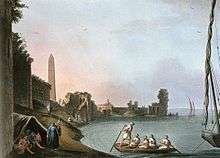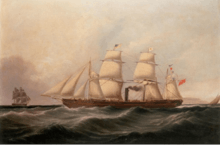54th (West Norfolk) Regiment of Foot
| 54th (West Norfolk) Regiment of Foot | |
|---|---|
| Active | 1755–1881 |
| Country |
|
| Branch |
|
| Type | Infantry |
| Size | One battalion (two battalions 1800–1802) |
| Garrison/HQ | Normanton Barracks, Derbyshire |
| Engagements |
American Revolutionary War French Revolutionary Wars Napoleonic Wars Fifth Xhosa War First Anglo-Burmese War Indian Rebellion |
The 54th Regiment of Foot was an infantry regiment of the British Army, raised in 1755. Under the Childers Reforms it amalgamated with the 39th (Dorsetshire) Regiment of Foot to form the Dorsetshire Regiment in 1881.
History
_by_Thomas_Gainsborough.jpg)
Early history
The regiment was raised in Salisbury by John Campbell, 5th Duke of Argyll in 1755 as the 56th Regiment of Foot for service in the Seven Years' War.[1] It was re-ranked as the 53rd Regiment of Foot, following the disbandment of the existing 50th and 51st regiments, in 1756.[2] The regiment was deployed to Gibraltar in 1756 and remained there until it moved to Ireland in 1765.[3]
American Revolution
The regiment was deployed to North America for service in the American Revolutionary War in 1776[4] and first saw action at the Battle of Sullivan's Island in June 1776.[5] It went on to fight at the Battle of Long Island in August 1776,[5] the Battle of Rhode Island in November 1776[5] and the Battles of Danbury and Ridgeway in April 1777.[4]
In May 1778 100 men of the 54th Regiment of Foot embarked on boats to attack saw mills at Fall River, Massachusetts. The galley Pigot and some armed boats were to provide support. Pigot grounded, but the attack proceeded anyway. A sharp skirmish ensued when the troops arrived at their objective. Even so, they were able to destroy one saw mill and one grain mill, as well as a large stock of planks and boards, other buildings, some cedar boats, and so on. They then withdrew, having lost two men killed and five officers and men wounded. As the tide returned, Pigot was floated off, but as Flora towed her off, Flora lost two men killed and a lieutenant severely wounded.[6]
The regiment went on to assault Fort Griswold in Groton, Connecticut, at the Battle of Groton Heights in September 1781.[7] The battle resulted in almost 80 American soldiers being massacred by the British after the American commander, Lieutenant Colonel William Ledyard, had surrendered.[8] The regiment returned home in 1781 and adopted a county designation becoming the 54th (West Norfolk) Regiment of Foot in 1782.[2]
Napoleonic Wars

In June 1794 the regiment embarked for Flanders for service in the French Revolutionary Wars.[9] The regiment returned to England in 1795 but then embarked for the West Indies later in the year where it helped suppress an insurrection by caribs on Saint Vincent in 1796.[10] A second battalion was raised in May 1800 to increase the strength of the regiment.[2] Both battalions took part in the unsuccessful Ferrol Expedition in August 1800 and the subsequent equally unsuccessful attack on Cádiz in October 1800.[11] Both battalions then embarked for Egypt for service in the French campaign in Egypt and Syria.[12] They saw action at the Battle of Abukir in March 1801, the Battle of Alexandria later that month and the Siege of Cairo in June 1801.[13] The 1st battalion also took part in the Siege of Alexandria where it encountered fierce opposition at Fort Marabout in August 1801: the battalion eventually carried out a successful assault on the fort.[14] The battalions amalgamated again in May 1802 and the regiment moved to Gibraltar in 1803.[15]
In early 1807 the regiment embarked on the Second invasion of the River Plate under the leadership of Sir Samuel Auchmuty: it saw action at the Battle of Montevideo in February 1807[16] and Second Battle of Buenos Aires in July 1807.[4] The regiment was sent to Stralsund in Swedish Pomerania 1810 and remained there until the Battle of Waterloo in June 1815: its only involvement at Waterloo was capturing Cambrai in the aftermath of the battle.[17]
The regiment was sent to South Africa in 1819 for service in the Fifth Xhosa War.[18] It moved to India in 1822 and to Burma in 1824 for service in the First Anglo-Burmese War: it formed part of an army which advanced up the River Irrawaddy to the Kingdom of Ava before returning to India in 1825 and embarking for England in 1840.[19]
Indian rebellion

On deployment to India during the Indian Rebellion about 350 men and five women of the headquarters, 54 Regiment, were aboard SS Sarah Sands, one of the earliest iron, screw type steamers, when fire broke out on 11 November 1857.[20] The ship had been built in 1846 and had previously been chartered by the British government for the Crimean War and was again under charter transporting troops and a large amount of powder and ammunition carried in two magazines.[21] The ship was a thousand miles from nearest land and outside shipping lanes, and if lost with all aboard would have been another mystery, though messages were placed in bottles that were never found.[20] Some of the crew, which had been troublesome since sailing, abandoned ship in the two best boats leaving the ship's officers, remaining crew and men of the regiment to fight the fire.[21] The ladies were put in a boat with what provisions could be found and Private William Wiles of the regiment and ship's Quartermaster Richard Richmond risked their lives to save the regimental colours from below decks.[22]
The starboard magazine was cleared of explosives but the port magazine was reached only through suffocating smoke and volunteers led by Major Hughes cleared what they could but two large barrels of powder could not be brought up to be thrown overboard.[22] At about nine in the evening the fire broke through the deck, set fire to rigging and shortly after the expected explosion of the powder occurred blowing out the after cabins, remnants of the saloon and ship's port quarter, even causing the ship's stern to momentarily dip under water. Though rafts had been prepared the remaining crew and troops continued to fight the fire through the night, cutting through the deck and using buckets to fight the fire that was beginning to turn the iron hull red hot. By nine the next morning the fire was under control but the ship's after portion was entirely burned out, with even glass in the ports melted, and flooded with loose water tanks smashing against the hull. Those in boats were recovered, the stern was strengthened with an arrangement of chain and leaks stopped with sail and steering managed by a system of six men sitting on planks rigged each side of the rudder controlling it using ropes. Thus the ship made the nearly thousand miles to Mauritius arriving on 25 November despite miseries endured with short rations of food and water. The regiment was sent to Calcutta in another vessel and Sarah Sands was repaired enough to sail for Britain and full repair to sail for Bombay as a sailing ship—where she ran aground and was so badly damaged that she was abandoned.[22] The iron construction, aided by three iron watertight bulkheads, one constantly kept cool by troops wetting it with water, saved the ship and probably all the lives and later substantially helped remove prejudice against iron vessels.[22] The regiment saw little action during the rebellion and returned to England in 1866 but was re-deployed to India in 1871.[23]
Amalgamation
As part of the Cardwell Reforms of the 1870s, where single-battalion regiments were linked together to share a single depot and recruiting district in the United Kingdom, the 54th was linked with the 95th (Derbyshire) Regiment of Foot, and assigned to district no. 26 at Normanton Barracks in Derbyshire.[24] On 1 July 1881 the Childers Reforms came into effect and the regiment amalgamated with the 39th (Dorsetshire) Regiment of Foot to form the Dorsetshire Regiment.[2]
Battle honours
Battle honours won by the regiment were:[2]
- Marabout, Egypt
- Second Burmese War: Ava
Colonels of the Regiment
Colonels of the regiment were:[2]
56th Regiment of Foot - (1755)
- 1755–1757: F.M. John Campbell, 5th Duke of Argyll (Marquess of Lorne)
54th Regiment of Foot - (1756)
- 1757–1760: Gen. John Grey
- 1760–1770: Gen. John Parslow
- 1770–1801: Gen. Mariscoe Frederick
54th (the West Norfolk) Regiment of Foot - (1782)
- 1801–1807: Gen. Sir David Baird, 1st Baronet, GCB, KC
- 1807–1808: Gen. Oliver Nicolls
- 1808–1809: Gen. Hon. Edward Finch
- 1809–1816: Gen. James Ochonar Forbes, 17th Baron Forbes
- 1816–1841: Gen. Isaac Gascoyne
- 1841–1845: Lt-Gen. Sir Henry Sheehy Keating, KCB
- 1845–1850: Gen. Ulysses de Burgh, 2nd Baron Downes, GCB
- 1850–1856: Lt-Gen. William Alexander Gordon, CB
- 1856–1860: Gen. Sir William John Codrington, GCB
- 1860–1868: Gen. Mildmay Fane
- 1868–1876: Gen. Studholme John Hodgson
- 1876–1877: Gen. David Elliot Mackirdy
- 1877–1880: Gen. Lord Mark Ralph George Kerr, GCB
- 1880–1881: Gen. John Ramsay Stuart, CB
- 1881 Regiment amalgamated with the 39th (Dorsetshire) Regiment of Foot to form the Dorsetshire Regiment
References
- ↑ Records, p. 3
- 1 2 3 4 5 6 "54th (West Norfolk) Regiment of Foot". regiments.org. Archived from the original on 18 April 2007. Retrieved 16 July 2016.
- ↑ Records, p. 4
- 1 2 3 "54th (West Norfolk) Regiment of Foot: locations". Archived from the original on 9 June 2007. Retrieved 7 January 2017.
- 1 2 3 Records, p. 5
- ↑ "No. 11909". The London Gazette. 12 September 1778. p. 3.
- ↑ Records, p. 11
- ↑ Allyn, p. 170
- ↑ Records, p. 16
- ↑ Records, p. 18
- ↑ Records, p. 20
- ↑ Records, p. 21
- ↑ Records, p. 23
- ↑ Records, p. 24
- ↑ Records, p. 25
- ↑ Records, p. 34
- ↑ Records, p. 41
- ↑ Records, p. 47
- ↑ Records, p. 57
- 1 2 Bradlee, p. 82
- 1 2 Bradlee, pp. 82-83
- 1 2 3 4 Bradlee, p. 83
- ↑ Records, p. 84
- ↑ "Training Depots". Regiments.org. Archived from the original on 10 February 2006. Retrieved 16 October 2016.
Bibliography
- Allyn, Charles (1999) [1882]. Battle of Groton Heights: September 6, 1781. New London: Seaport Autographs. ISBN 978-0-9672626-1-1. OCLC 45702866.
- Bradlee, Francis B. C. (1913). "The Burning of the Sarah Sands". International Marine Engineering. New York: Aldrich Publishing Company. 18 (February 1913). Retrieved 1 March 2015.
- Brown, Steve; Burnham (Ed.), Robert (September 2014). "British Infantry Regiments and the Men Who Led Them 1793-1815—54th Regiment of Foot" (PDF). The Napoleon Series. Retrieved 1 March 2015.
- Pigot, Major General (1778). "Copy of a letter from Major General Pigot to Sir Henry Clinton". The London Gazette. London (12 September 1778). Retrieved 1 March 2015.
- Records of the 54th West Norfolk Regiment. Thomason Civil Engineering College Press. 1881.
Further reading
- Edwards, Francis (1908). Edwards's Military Catalogue—Entry for Records of the Fifty-fourth, West Norfolk Regiment in 8 volumes by Roorkee, 1851. London: Francis & Co., The Athenæum Press.
External links
- Narrative of the Burning of the Sarah Sands Screw Steam Ship With the Headquarters of H. M. 54th Regiment On Board (1870 account by "A Late 54th Officer")